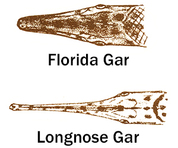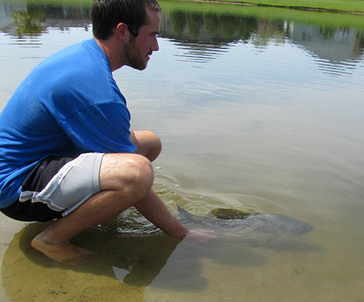
The FWC's TrophyCatch citizen-science program is now well underway with its seventh season! Milestones since TrophyCatch's start in 2012 include:
- 26,556 registrants
- 8,136 approved submissions
- 55 documented Hall of Fame size bass 13 pounds or larger.
|
If you're new to TrophyCatch, the program is a direct response to FWC’s Black Bass Management Plan, which placed an emphasis on establishing trophy bass fishing opportunities throughout the state. TrophyCatch was established to collect data on trophy bass while promoting bass conservation by rewarding catch-and-release fishing. Various industry partners have teamed up with FWC to make this program not only fun, but rewarding. Just by registering, you are automatically entered into a free drawing for a Phoenix bass boat, and you don't have to submit a fish to win! The primary submission requirement is a photo showing the entire bass on a scale, with the weight reading clearly visible. Our biggest tip to new participants is to not cut off the tail in the photo—the entire fish must be visible. |
|
 |

Hall of Fame (HOF) bass weighing 13 pounds or more are extremely rare nationwide and are one of the factors that make Florida the Bass Fishing Capital of the World! Each of these giants submitted to TrophyCatch would be the state record in over half the United States! Several TrophyCatch participants have made the incredible accomplishment of catching not one, but two or more of these once-in-a-lifetime fish that they have submitted to the program. In fact, participant Syl Sims (left) used the Enigma rod he received for submitting one HOF bass to catch this one!
|

Size: The Big Catch minimum qualifying sizes are 4 pounds or 28 inches for adults, and 3 pounds or 21 inches for youth (BigCatchFlorida.com). The State Record is 9.44 pounds.
|

Identification and similar species: The Florida gar is a long fish with a narrow, toothed mouth and bony scales that form a hard armor. Irregular round spots occur on top of the head, all over the body and fins. A number of "new" State Records that have been reported to FWC have turned out to be longnose gar, which can be distinguished from the Florida gar by a longer and narrower mouth and the presence of small bony plates on the underside of the head.
Angling qualities: Gar receive a "bad rap" among anglers because they steal shiners and can scratch up lures intended for bass. However, they are a natural part of Florida's freshwater ecology and often surprise anglers with a sporting fight. Gar can be caught with minnows, bacon, artificial lures or frayed nylon cord that entangles the gar’s teeth. Food value, however, is considered poor.
Where to catch them: Florida gar are found in the Ochlockonee River and waters east and south into peninsular Florida where they inhabit streams, canals and lakes with mud or sand bottoms near underwater vegetation. They are common to abundant throughout central and peninsular Florida. They will often stack up like the proverbial cordwood near culverts or other areas with an outflow.
Interesting facts: Gar use an airbladder to breathe air in low-oxygen water. Spawning occurs in late winter and early spring when both sexes congregate in shallow weedy waters where the females lay adhesive eggs. Newly hatched young possess an adhesive organ on the end of their snout and stay attached to vegetation until 3/4-inch long. Adults primarily feed on fish, shrimp and crayfish.
Gar illustration by Duane Raver, Jr; head images FWC illustration.
|

Size: 75,976 acres in total. Comprised of eight lakes larger than 1,000 acres each, including Lake Apopka which is the fourth largest lake in Florida.
Location: Lake and Orange Counties.
Description: The Harris Chain of Lakes is one of the five largest chain of lakes in central Florida. The lakes alone, not including the numerous canals and creeks connecting the chain, total 76,000 acres of fishing paradise. The chain supports abundant and diverse vegetation that provides excellent opportunities for fishing bass to bluegill. Since the start of Florida’s TrophyCatch Program, the Harris Chain has accumulated 250 approved TrophyCatch fish through May 2018. Of those catches, 216 are Lunker Club (8-9.9 lbs.) and 34 are Trophy Club (10-12.9 lbs.). Lake Harris is the highest contributor with 80 approved catches followed closely by Lake Griffin with 76 catches. Recently Field & Stream listed the Harris Chain as the best fishing spot in Florida. Also, the Recreational Boating & Fishing Foundation (RBFF) has recommended the Harris Chain as one of the top 10 fishing destinations in Florida. The FWC has constructed 35 artificial fish attractor areas located in Lake Griffin (18), Lake Harris (7) and Lake Dora (10) to enhance fishing opportunities. Another favorite sportfish is the sunshine bass stocked annually into Lake Harris, with over 200,000 stocked in 2018. The Harris Chain of Lakes also received great recognition during 2018 in hosting several very successful major tournaments: FLW, B.A.S.S., Bass Pro Shops Big Bass Tour and just recently the BassMaster Team Championship. Whether you are a pro or a “weekend warrior,” the Harris Chain is worth a trip!
|
 |
TrophyCatch program participant AJ Jackson successfully releases a healthy trophy largemouth bass.
Unless fishing for the frying pan, an angler has a vested interest in keeping his catch lively, whether he is planning to release it immediately, or to keep it aboard for that tournament weigh-in. The same applies to anyone trying to keep baitfish perky throughout a day-long outing. Understanding a fish’s basic needs and taking some small precautions will go a long way toward improving the survival of any fish.

-
Oxygen — A fish’s most immediate need (beyond water) is oxygen. When photographing or de-hooking your fish, keep it out of the water as little as possible. Place tournament fish in an oxygenated livewell quickly. Dissolved oxygen should be provided by an aeration or circulation system. Water holds less oxygen as its temperature rises, so be especially attentive to your fish on hot days. Also, having bigger fish in your livewell, or a large number of fish, will consume oxygen more rapidly. Shad in particular are sensitive to low oxygen levels, so provide this bait with plenty of aeration!
|

-
Temperature — A fish can experience temperature shock if there is too large a difference between the water it was just removed from and that in your livewell. Circulate new water into your livewell in order to keep it within about 3 degrees F of the water you are fishing in. However, on the hottest days you can increase the longevity of fish by keeping them in cooler water. When you are moving fish between waters of different temperatures, “temper” the water the fish is being transferred into by mixing in some water from the original source first.
|

-
Handle fish carefully and as little as possible. Always wet your hands before touching a fish to reduce the amount of slime removed from the fish’s body during contact. A fish’s slime covering protects it from various fungal, viral and bacterial diseases. A BogaGrip or similar fish-safe holding device can reduce the amount of hand contact required. Otherwise, handle fish such as bass by the lower jaw. Never grab fish behind the gill plates as this will cause contact with the fragile gills. Use a non-abrasive, “fish-friendly” landing net with a soft basket such as molded rubber, since cheaper and more readily-available nets with knotted nylon bags can scrape the fish.
|
- Don’t place fish you intend to release on a stringer. Stringers are for frying-pan fish only! Many anglers prefer instead to place their “eating fish” on ice immediately.
- Play and land a fish as quickly as possible. Light tackle anglers in particular should be cautious not to excessively tire fish in the name of sport or challenge. Revive an exhausted fish by gently moving it back and forth in the water to increase the flow of water and oxygen over its gills. Release the fish when it seems ready to swim off under its own power.

- Use barbless hooks to minimize the amount of time a fish must be kept out of the water during hook removal. Use forceps, pliers, or other de-hooking tools. Anglers might also consider replacing treble hooks on lures with single hooks to make releasing fish easier. Set the hook quickly when a fish strikes to reduce the chance of swallowing, especially when using bait. If a fish does swallow the hook, cut the line as close to the hook as possible but do not try to remove the hook itself. Circle hooks have become popular with bait anglers because they not only have a higher percentage of solid hookups, but because they usually hook the fish in the mouth and are seldom swallowed.
- Choose fine-wire hooks (such as the popular Aberdeen style) when using fish as live bait. The light weight of the wire will allow the bait to swim more freely. Hook baitfish through the lips or just under the dorsal fin, avoiding the backbone.
- If you have room install a round or oval livewell in your boat for baitfish like shad that swim continuously. This will eliminate square corners in the baitwell and make it easier for tank residents to avoid bumping into the sides.
These tips should help you keep your bass or your bait lively for a successful trip!
|
To contact the Florida Freshwater Angler, email John Cimbaro.
|